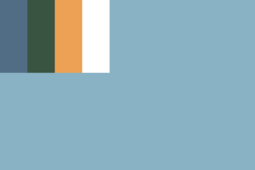Flag and coat of arms of Freice
 | |
| Use | Civil and state flag, civil and state ensign |
|---|---|
| Proportion | 1:2 |
| Adopted | 17 January 1970 |
| Design | A light blue field with a rectangle on the upper hoist-side corner bearing the colours blue, green, yellow, and white in vertical bars. |
| Designed by | De̩zȧ Tudɉe̩go and Toqư Eɉɨsta |
The National Flag of the Country of Freice (Freician: Serɉeɱą ągrǡjɨl ġiḡurą pưƞqyǡ 'gi frɨs), often referred to simply as the flag of Freice and sometimes as the Blue and Bars (Ɨgo ol e̩siqɨǡ) was adopted in its current form by the provisional Freician legislature on 17 January 1970.[1] The flag consists of a light blue field with a canton featuring four verticle stripes of stripes of blue, green, yellow, and white.[2][Note 1]
The origins of the current flag can be traced to 1959, when a horizontal tricolour flag featuring the colours blue, green, and yellow, and a white depiction of Freice, was first flown. The flag's creator remains unknown, but it was quickly adopted by Freician nationalists as a symbol of nationhood and sovereignty.[3] In 1961, a new version of the flag was adopted that took the tricolour flag and added a fourth white band in place of the central island symbol.[4] This design was the basis design that was incorporated into the current national flag.
History
The first flag that was used to represent Freice featured four horizontal bars of blue, green, yellow, and white. This flag was designed by Deza Tudjego, a political figure aligned with the Committee for Liberation, a paramilitary and political organization working for the independence of Freice from colonial rule. The flag came to be used by the Committee as their official flag and, because of this, came to be associated with Frecian independence.
Upon independence in 1969, the four-bar banner was adopted as the national flag of Freice due to its association with Frecian independence and its visibility amongst the Frecian people. However, controversy over the Committee for Liberation's role in the killing of a policeman and a woman in 1964 created discontent amongst some over the use of a flag so closely associated with the organization. Toqu Ejista, a member of the Constituent Assembly, created a new variant, featuring the same colours, but in a vertical form, in the top-left corner, with a blue field. This new flag was approved by the Constituent Assembly in January 1970, its use finally formalized in the Constitution enacted the following year.
Design and symbolism
The colours of the flag represent both political and geographic meanings. The vertical bars, originally used by the Committee of Liberation, link back to the campaign for independence and, more broadly, Freican sovereignty and independence. The colours themselves carry geographic meanings; the blue represents the sky (the dark colour linking to the cultural festivals historically carried out in the evening), the green represents the land, the yellow represents the sun, and the white represents the peace that exists between these co-existent elements, and between them and the Freician people.
The blue field represents the ocean that surrounds Freice and the importance of the sea and water in Frecian life. Moreover, the four bars in the upper-left hoist corner represents Freice's position surrounded by water and Anteria's all-encompassing nature.
Gallery
Notes
- ↑ There is some debate about the exact specifications of the flag's design. The Schedules of Government and its predecessor, the Constitution, specify the design of the flag. However, the initial legislation that officially adopted the flag differs slightly in the shades of colour used. The government has not, as of 2021, identified a correct way of rendering the flag.
